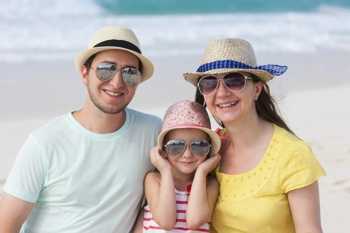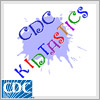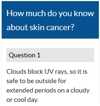Skin Cancer Awareness
 Learn how to lower your skin cancer risk and get resources to share from CDC!
Learn how to lower your skin cancer risk and get resources to share from CDC!
Skin cancer is the most common cancer in the United States, and includes different types. Exposure to ultraviolet (UV) rays causes most cases of melanoma, the deadliest kind of skin cancer. To lower your skin cancer risk, protect your skin from the sun and avoid indoor tanning.
Sun Safety Tips
Plan your sun protection using these tips—
- Seek shade, especially during midday hours.
- Cover up with clothing to protect exposed skin.
- Wear a hat with a wide brim to shade the face, head, ears, and neck.
- Wear sunglasses that wrap around and block as close to 100% of both UVA and UVB rays as possible.
- Use sunscreen with broad spectrum (UVA and UVB) protection and a sun protection factor (SPF) 15 or higher.
- Remember to reapply sunscreen at least every 2 hours and after swimming, sweating, or toweling off.
Fast Facts About Skin Cancer
- Unprotected skin can be damaged by the sun’s UV rays in as little as 15 minutes. Yet it can take as long as 12 hours for skin to show the full effect of sun exposure. Plan ahead so that when you’re having fun outdoors, you won’t forget to protect yourself from the sun.
- Even if it’s cool and cloudy, you still need protection. UV rays, not the temperature, do the damage.
- Tanned skin is damaged skin. Any change in the color of your skin after time outside indicates damage from UV rays.
- Anyone can get skin cancer, but some things put you at higher risk.
- Indoor tanning exposes users to UVA and UVB rays, which damage skin and can lead to cancer.
- A change somewhere on your skin is the most common sign of skin cancer. This could be a new growth, a sore that doesn’t heal, or a change in a mole.
Featured Resources
 Our “Tanned Skin Is Not Healthy Skin” poster explains that every time you tan, you increase your risk of melanoma.
Our “Tanned Skin Is Not Healthy Skin” poster explains that every time you tan, you increase your risk of melanoma.

Two people talk about how they’ve learned to protect their skin from the sun in this podcast.

Men are more likely than anybody else to get skin cancer, but there are easy ways to protect yourself.
 This infographic explains how to use a layered approach to protect all the skin you’re in.
This infographic explains how to use a layered approach to protect all the skin you’re in.
 “I learned the hard way: a tan is not a sign of health,” writes melanoma survivor Sharon McKenna.
“I learned the hard way: a tan is not a sign of health,” writes melanoma survivor Sharon McKenna.
 Our skin cancer prevention fact sheets list strategies for parents, teachers, employers, and parks and recreation staff.
Our skin cancer prevention fact sheets list strategies for parents, teachers, employers, and parks and recreation staff.
 In the “Sun Proof” podcast, the Kidtastics talk about the harmful effects of the sun and how to protect yourself.
In the “Sun Proof” podcast, the Kidtastics talk about the harmful effects of the sun and how to protect yourself.

Test your knowledge about skin cancer with this simple quiz!
 Schools can help protect students from skin cancer. Read CDC’s tips.
Schools can help protect students from skin cancer. Read CDC’s tips.
- Page last reviewed: June 29, 2017
- Page last updated: June 29, 2017
- Content source:
- Maintained By:


 ShareCompartir
ShareCompartir